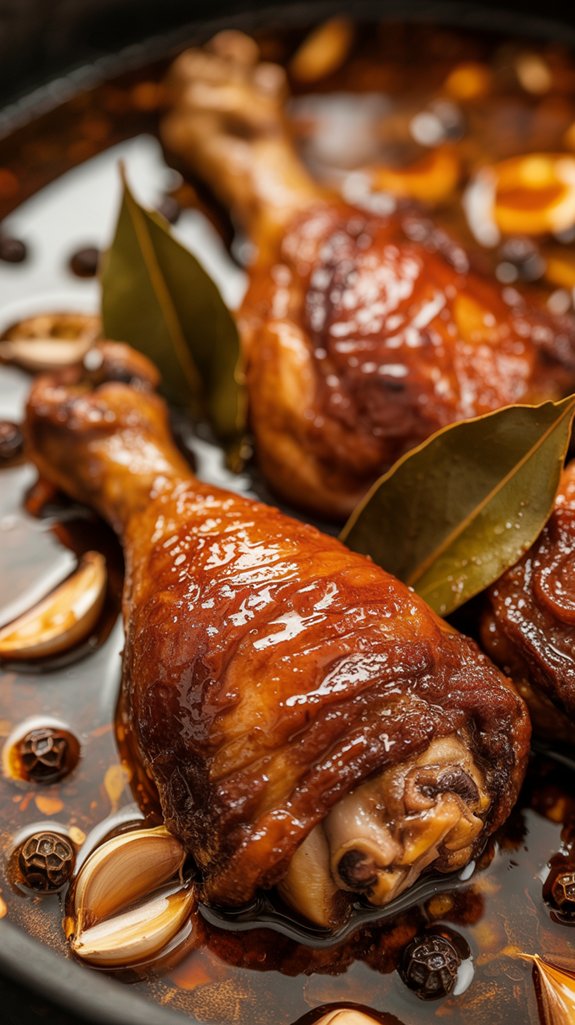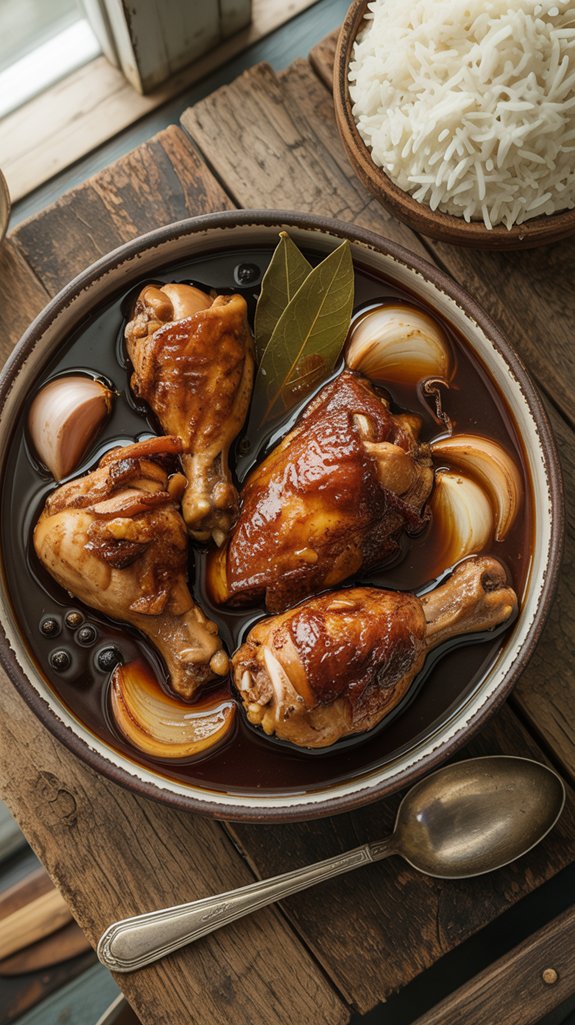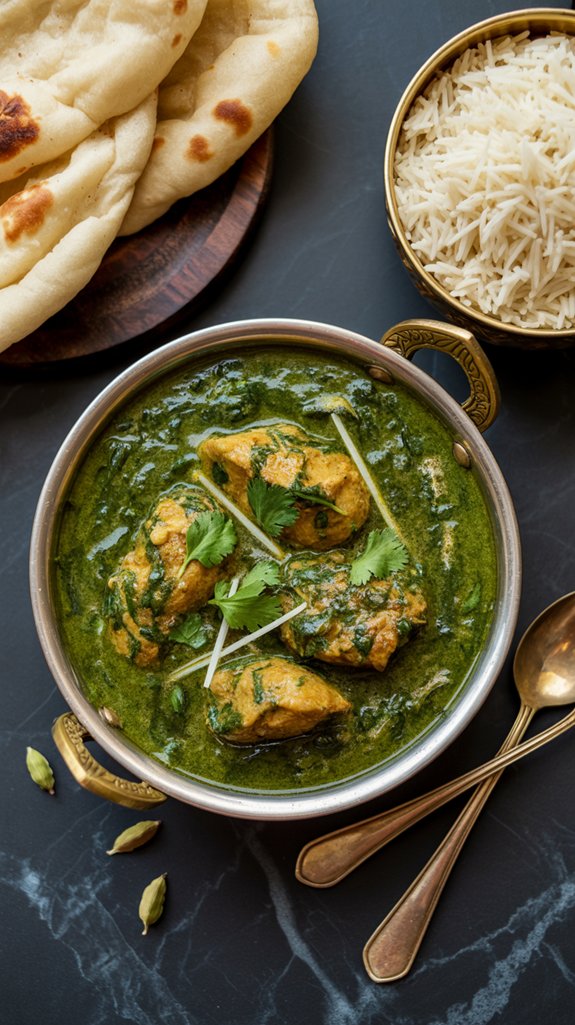Why You’ll Love This this Filipino Chicken Adobo
This Filipino chicken adobo delivers that perfect balance of tangy vinegar and rich soy sauce that makes your taste buds do a little happy dance.
The marinating step might seem like extra work, but trust me, it’s what transforms ordinary chicken into something that’ll have you questioning why you ever ordered takeout.
Plus, browning the chicken at the end gives you that gorgeous caramelized exterior that looks way fancier than the effort you actually put in.
Ingredients List
Let me break down everything you’ll need to create this Filipino masterpiece that’ll make your kitchen smell absolutely incredible.
- 1 cup white vinegar
- 2 garlic cloves, pressed
- 1 bay leaf
- 1 1/2 teaspoons peppercorns, lightly crushed
- 1/2 cup reduced sodium soy sauce
- 6 chicken legs, cut into drumstick and thigh pieces
- 1 cup water
- 3 tablespoons canola oil
- 4 tablespoons cilantro, chopped
Ingredient Health Notes:
- This recipe uses reduced sodium soy sauce, which cuts down on the salt without sacrificing that deep, umami flavor
- Dark meat chicken like thighs and drumsticks brings more iron and zinc to the table compared to white meat
- The vinegar isn’t just for tang – it actually helps tenderize the meat naturally
- You can swap the canola oil for avocado oil if you want to bump up the healthy fats a bit
Step by Step Directions

Follow these straightforward steps to create authentic Filipino chicken adobo with perfectly tender meat and rich, tangy sauce.
- Marinate the chicken: In a large glass baking dish, mix together the vinegar, garlic, bay leaf, peppercorns, and soy sauce. Add the chicken and toss to coat. Cover and marinate for 1 hour in the refrigerator.
- Simmer the chicken: Transfer chicken and its marinade to a large saucepan. Add water and bring to a boil. Cover, reduce heat to low, and simmer 20 minutes.
- Remove and cool chicken: Using tongs, transfer chicken to a plate to cool. Pat chicken dry with paper towels.
- Reduce the sauce: Boil the remaining cooking liquid about 10 minutes, or until reduced to 1 cup. Allow sauce to cool, then strain into a small saucepan. Skim off fat and reheat.
- Brown the chicken: In a large skillet, heat oil over high heat until quite hot. Brown chicken in batches, about 2 minutes per side.
- Serve: Transfer chicken to a deep platter and pour hot sauce over chicken. Garnish with cilantro if desired.
While traditional Filipino cuisine uses different techniques, having the right cooking equipment set can make preparing dishes like adobo much more efficient and enjoyable.
Substitutions and Variations
• Garlic lovers, unite: Two cloves? That’s just a suggestion.
I’m not going to stop you from doubling or tripling that amount. More garlic never hurt anyone’s feelings.
Additional Things to Serve With This Dish
This dish practically begs for some starchy sidekicks to soak up all that tangy, savory sauce.
- Steamed jasmine rice – The classic choice, and honestly, you can’t go wrong here. That fluffy rice will drink up every drop of the adobo sauce like it’s getting paid to do it.
- Garlic fried rice – Because if we’re already loading up on garlic in the adobo, why not double down? Sometimes more is more, and I’m not apologizing for that philosophy.
- Simple sautéed vegetables – Think bok choy, green beans, or broccoli with just a touch of garlic and soy sauce. You need something fresh to cut through all that rich, vinegary goodness.
- Pickled vegetables – I know, I know, more vinegar? But trust the process here. Some quick pickled cucumbers or radishes will cleanse your palate between bites.
- Crusty bread or dinner rolls – Not traditional, but who’s keeping score? Sometimes you just want to mop up that sauce with something soft and pillowy.
- A cold beer – Okay, this isn’t exactly food, but that tangy adobo sauce and a crisp, cold brew? They’re practically best friends waiting to happen.
Cooking Tips & Tricks (Chef’s Notes)
Getting this dish right is all about patience and not fighting the process, even when your kitchen starts smelling so good you want to skip straight to the eating part.
- Don’t skip the marinating time – I get it, an hour feels like forever when you’re hungry, but that marinade needs time to work its magic into the chicken. If you’re really planning ahead, overnight marinating makes it even better.
- Pat that chicken completely dry before browning – Wet chicken equals sad, pale chicken instead of those gorgeous golden-brown pieces you’re after. Use way more paper towels than seems reasonable.
- Brown in batches, not all at once – Crowding the pan just steams everything into submission. Give each piece some breathing room, even if it means making multiple trips to the skillet.
- Taste your sauce before serving – Every brand of soy sauce and vinegar hits differently, so adjust with a splash more of whatever it needs. Too salty? Add a pinch of sugar. Too sharp? A bit more soy sauce balances it out.
- Let the sauce reduce properly – That concentrated, glossy sauce is where all the flavor lives. If it looks watery, keep boiling it down until it coats the back of a spoon.
- Save some sauce for later – Trust me on this one. Drizzle extra over your rice, or honestly, just keep it in the fridge for dipping everything into for the next few days.
Nutritional Facts
Based on 6 servings, each portion of Filipino Chicken Adobo delivers solid protein with moderate calories, making it a satisfying meal that fits well into most balanced diets.
- Calories per serving: Approximately 285-320 calories
- Protein: 28-32 grams (excellent source for muscle maintenance and satiety)
- Fat: 12-15 grams (primarily from chicken skin and cooking oil)
- Carbohydrates: 8-10 grams (mainly from soy sauce and natural sugars)
- Sodium: 980-1,200mg (about 40-50% daily value – consider low-sodium soy sauce if watching intake)
- Cholesterol: 85-95mg
- Fiber: Less than 1 gram
- Sugar: 6-8 grams (naturally occurring from soy sauce and vinegar)
- Iron: 8-10% daily value (good source from dark meat chicken)
- Potassium: 250-300mg (supports heart and muscle function)
- Vitamin B6: 15-20% daily value (important for metabolism and brain function)
- Phosphorus: 12-15% daily value (essential for bone health)
Fun “Did You Know?”
Did you know that chicken adobo wasn’t originally made with soy sauce? Traditional Filipino adobo relied solely on vinegar, garlic, and spices for its distinctive tangy flavor.
Spanish colonizers introduced the cooking method, but Filipinos made it uniquely their own. The addition of soy sauce came later through Chinese influence, creating the version that’s recognized today.
I find it fascinating that adobo actually preserves meat naturally – the vinegar’s acidity prevents spoilage, making it perfect for tropical climates without refrigeration.
Each Filipino family has their secret adobo recipe, often passed down through generations with personal tweaks and variations.





